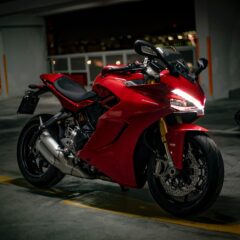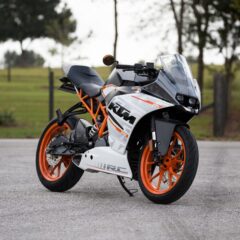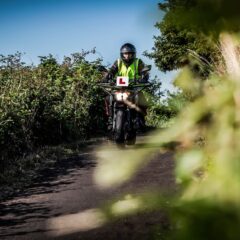
7 Top Motorcycle Accessories
With Christmas just around the corner, you might be wondering what to get your favourite motorcycle enthusiast or even a little something for yoursel...
 Phoenix Motorcycle Training LTD
Phoenix Motorcycle Training LTD
 Phoenix Motorcycle Training LTD
Phoenix Motorcycle Training LTD

Getting a UK motorcycle licence can seem a complicated process. Particularly when compared to a driving licence for a car. Whether you choose the progressive route and start by getting your CBT at age 16, or go with a Direct Access course when you’re a little older, the licence level you achieve will affect the power of the bike you can legally ride. Today, we’re going to dive into the age and power restrictions for UK motorcycle licences. You’ll also find some details on what you can expect from each power category.
Most people need to start with their compulsory basic training. This certifies that they know enough of the basics to keep practising their motorcycle skills on the road. You can’t go riding on motorways or carry pillion passengers. The youngest you can take this training and be let loose on public roads is 16 years old. You’ll also need a provisional driving licence or higher. Power restrictions for 16 – 17-year-olds who have their DL196 certificate are the lowest of all. You’ll be looking for a motorbike that has a top speed of roughly 28mph and a power rating of 50cc.
If you’re older than 17 and have your DL196 certificate, you can ride a slightly higher-powered motorcycle or moped – 125cc is the limit. Most motorcyclists would advise looking for a second-hand motorbike for your first set of wheels. There are some pretty nice lower-powered bikes out there whether the moped or motorcycle is new or pre-loved.
After riding for a year or so on your DL196 certificate or taking some advanced courses to improve your skill faster, it’s time for your next step. With the progressive route that’s the UK’s A1 motorcycle licence.
Older riders, and by that we mean 24 years or more, can skip straight to claiming one of the full A-level UK motorcycle licences.
The earliest you can sit the test for the A1 motorcycle licence is 17 years of age. With this licence level, you can ditch the L plates, use the motorways and carry a pillion. If choosing to do the latter, it’s worth taking a course for carrying pillion passengers before you take someone’s life in your hands. Power restrictions sit at 125cc, and ages for this licence range from 17 to 19 years old. You’ll find the top speed for these bikes is somewhere around 70mph and acceleration is pretty snappy too. There’s a fairly wide choice for style, 125cc’s come in sports, cruisers and street bikes.
If you’re in your early twenties and decided to take up riding a motorbike, it’s likely you’ll be aiming for an A2 licence. Similar to the above-mentioned A1 licence, you’ll have the freedom to take to the motorway and carry a friend along too. We’d still recommend learning the ins and outs of carrying a pillion passenger as it’s a big responsibility. With age comes a little more freedom and this licence level is no different. You’ll be looking for motorbikes that are somewhere around the 550 – 600cc mark. Your test will be taken on a bike that is no less than 249cc. It’s a big jump and the range of bikes available can be a little confusing. Especially as it’s not just about the power; it’s the power-to-weight ratio. In this case, that’s no more than 0.2Kw of power per kilo.
If you’ve been stepping up the motorcycle licence levels since you were almost 16, you can go for your full unrestricted motorcycle licence at the age of 21. The rest of us who were a little slow to realise we were made for two wheels have to reach our 24th birthday (or beyond). Tests for full licences are carried out on motorbikes with a minimum power level of 595cc’s. It’s also worth noting here that while you can’t test on a lower-powered motorbike, neither can you practice on a bike with this much grunt unless you are accompanied by a qualified and DSVA-approved motorcycle instructor. Once you hold a full unrestricted motorcycle licence, the world of motorbikes is your oyster. If you’ve always dreamed of riding a classic 1200cc Harley, this is the licence you’ll need to do it.
A higher-powered bike doesn’t necessarily mean more fun. Lots of us get our A2 licence, or even an A1, and are happy with our motorbikes. There is no obligation to climb the motorcycle licence ladder as you get older. If the bike you’re riding meets your needs and gets you efficiently from A to B there’s no shame with sticking where you are. The best bikes aren’t the fastest or the most powerful, they’re the ones that give you the most pleasure and are reliable, cost-effective machines.
No. Once you have achieved any level of the UK motorcycle licences, you are able to continue riding on that licence. It’s fine to stick to the relevant powered motorcycle or moped as long as you keep your licence valid. You will need regular renewals. These are every ten years until you are 70 years old. After that, you must self-certify your fitness to ride every 3 years after the age of 70.

With Christmas just around the corner, you might be wondering what to get your favourite motorcycle enthusiast or even a little something for yoursel...

If you love motorcycle riding, you’ve probably daydreamed about riding a motorbike for a living. A professional racer or stunt rider is OK for some...

Getting a UK motorcycle licence can seem a complicated process. Particularly when compared to a driving licence for a car. Whether you choose the pro...
This website uses cookies to personalise content, ads, and analyse traffic, sharing data with partners who may combine it with other information. See our Privacy Policy for more information.